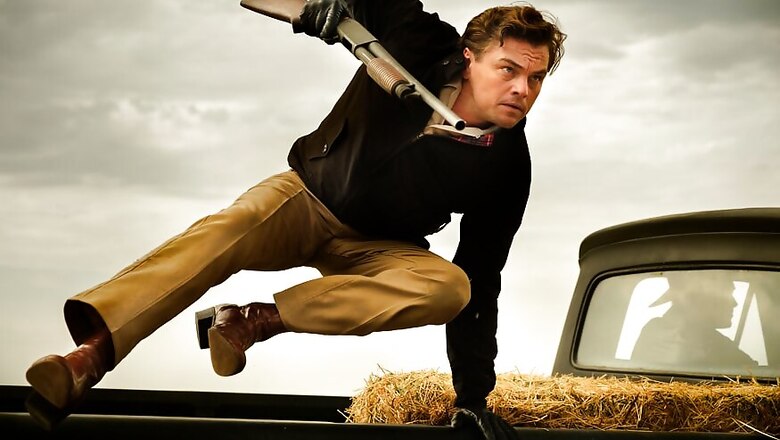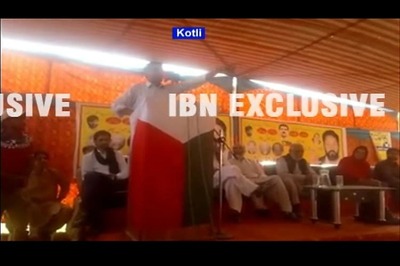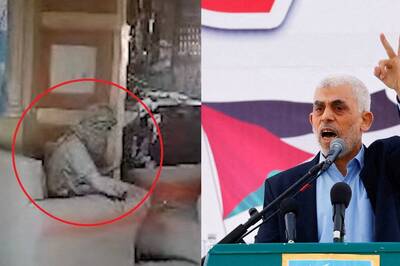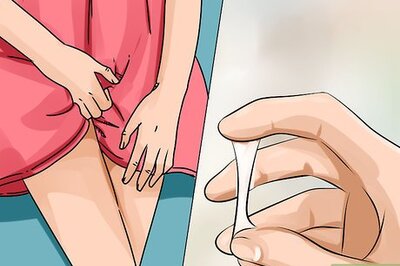
views
This post contains spoilers.
Once Upon A Time In Hollywood is a poetic reversal of history in which two fictitious characters Rick Dalton (Leonardo DiCaprio) and Cliff Booth (Brad Pitt) avert the real-life murders of actress Sharon Tate (Margot Robbie), Jay Sebring, Wojciech Frykowski, Abigail Folger and Steven Parent at Tate's Los Angeles home (on Cielo Drive) on the night of August 9, 1969.
These murders had serious social and cultural reverberations back in the day. They instigated panic across Hollywood prompting many Beverly Hills elites to upgrade their home security and invest in guns and guard dogs, and also curbed the counter-culture uprising -- the hippie movement -- that was in full swing at the time, bringing the decade of the 60s to a crashing halt.
In a way, Once Upon A Time In Hollywood has a fairytale ending in which the beautiful blonde actress Sharon Tate and her house guests aren't stabbed repeatedly or shot at mercilessly. They never even face the horrifying incident that claimed their lives. Instead, the onscreen counterparts of their real-life murderers meet a fatal end in the hands of Tarantino created characters, Rick and Cliff.
But, even a fairytale that's directed by Tarantino must have a considerable amount of blood and gore and this film's climax has enough violence to make Grimm Brothers' appear amateurs. This isn't the first time Tarantino has attempted to merge a fictitious storyline with real events, (remember Inglorious Basterds in 2009) and although it is a tricky business, leave it to Tarantino to get the tonality and texture of an era down to the smallest detail.
This film encapsulates every essence of 1960s, so much so that Tarantino himself has prescribed that the prospective viewers of this film watch a list of old Hollywood flicks --- Easy Rider, Bob & Carol & Ted & Alice, The Wrecking Crew (featuring the real Sharon Tate), The Battle of the Coral Sea and more -- to acclimatise themselves with the ‘60s and better understand the characters of Rick Dalton and Cliff Booth, as well as acquire some context of the cultural transition that the US was undergoing at the time in which this film is set.
Tate-LaBianca Murders
Nothing, however, is more closely related to this new Tarantino film than what has popularly been known as the Tate-LaBianca murders.
In reality, the morning the bodies of actress Sharon Tate and the four others who were killed in her house was discovered (10 August 1969), it looked exactly like a scene out of Tarantino's movie. The savageness with which each victim was either stabbed or shot shocked the United States, especially Hollywood.
Tate herself was eight months pregnant at the time of her murder and her unborn son died several minutes after she succumbed to stab wounds. On the front door of her house, the killers had written the word 'PIG' in bold, capital letters, in Sharon's blood. At the time of the murders, Sharon's husband, the famous filmmaker, Roman Polanski was in London shooting.
Polanski acquired an emergency visa and boarded a flight to LA as soon as the news of the death of his wife reached him. Heavily sedated and drowning in grief, the filmmaker, during the initial days after the murders, shunned the press, which didn't go in his favour at all, as many media reports started emerging that implied that all was not well in Polanski and Sharon Tate's marriage, and it did not help that LAPD initially thought of him as a suspect and only dropped that line of inquiry after he passed a polygraph test.
Polanski, however, was determined to find his wife's killer. So much so that he announced a reward of a hefty sum to anyone who could get the killer. This led to many false tips which in turn led to more dead ends, breaking his heart every single time.
Reports even claimed that he spied and bugged the houses of his acquaintances because he believed that the murderer was someone in his social circle. The LAPD had retrieved someone's glasses from the crime scene, and Polanski measured the power of the lens and then began comparing that with all his specs wearing friends' glasses. Once, when Bruce Lee said he had lost his glasses, he took him to the doctor to get a new pair and also to rule him out as a murderer, according to Karina Longworth podcast, You Must Remember This.
Read: Sacred Games 2 Review
Read: Batla House Movie Review
In the meantime, a middle-aged couple, Leno and Rosemary LaBianca were also murdered in the same fashion in another posh neighbourhood of Los Angeles. On their walls, the words, 'Death to Pigs' was written in blood. On Leno LaBianca's stomach, the word, 'War' was carved out, and misspelt titled of a The Beatles song, 'Helter Skelter' was written in blood on the refrigerator.
For several months, no one knew why the murders happened or who did them, and this lack of information, or a definite lead, lead to mass paranoia. Media speculated proactively, adding to the already existing panic. While some reports in the newspapers pointed towards the excesses of Tate and Polanski's lives and implied they had it coming -- the wild orgies that Polanski organised, the unbridled use of drugs -- others speculated black magic, beastality and voodoo. Whether there was any validity to such claims is disputable although the biographer Ed Sanders, who wrote, SharonTate: A Life also mentions the orgies, that apparently Sharon was forced to participate in.
It also did not help that the LAPD (Los Angeles Police Department) recovered large amounts of drugs and a sex tape of Polanski and Tate after the murders. It was one of the jail snitches who yapped about the murders and that is how LA police force finally caught the killers who were responsible for both Tate and Labianca murders -- Charles Manson and his 'family'.
The Manson Family
Charles Manson was a psychotic, delusional ex-con as well as a self-proclaimed God, and a wanna-be-rockstar. He headed a cult called 'Manson Family' which comprised of a small devoted group of followers, mostly women, who lived together on the abandoned Spahn Ranch, which used to serve as a set for old western films when Hollywood was still making Westerns.
The 'Manson family' paid for their stay to the 80-year-old Ranch owner in sexual favours from the women followers of the cult. All-day long, they tripped on acid or some other drugs, practised group sex and role play, and sang songs of their guru -- Charles Manson, and The Beatles. They were, in many ways, like most other hippies of the time, until of course, they started murdering people.
The big reason that Manson furnished for all the murders orchestrated by him, and committed by his followers, during Tate-LaBianca murder trials, was in fact, a Beatles single, Helter Skelter. He said that the song contained subliminal messages of 'rising' and 'killing', which instigated 'the children' (his followers) to kill Tate and others. He was mentally unstable and repeatedly told his followers about an impending apocalyptic race war from which they would emerge victorious, and all of his followers bought into that fantasy.
A more plausible reason for the murders was the fact that one of his cult members, Bobby Beausoleil, incited by Manson, had killed a musician, Gary Hinman, over a dispute about money and drugs. Beausoleil tried to cover his tracks and implicate The Black Panthers for the crime by writing 'Political Piggies' on the walls. Police, however, arrested Beausoleil. In order to replicate the same pattern of murders, so as to confuse the cops, and get Beausoleil out of jail, Manson planned those LA murders. The killings at Polanski's house happened because Manson knew the previous tenant of that property, Terry Melcher, who had refused to launch Manson's music career, and the LaBianca home was chosen because Manson had been to the house next door for a party, and knew the neighbourhood.
During the Tate-LaBianca murders, all the dirty jobs were done by Manson family members -- Tex Watson, Susan Atkins, Patricia Krenwinkel, and Leslie Van Houten (in LaBianca case), Manson, never picked up a knife or shot a gun to kill anyone, which made it hard to convict him, but he was eventually sentenced to life imprisonment.
The Hippie Movement and the end of the 60s
Another crime that Manson is responsible for, is single-handedly killing the hippie movement and ending the 60s.
"Many people I know in Los Angeles believe that the Sixties ended abruptly on August 9, 1969, ended at the exact moment when word of the murders on Cielo Drive travelled like brushfire through the community, and in a sense this is true ." wrote Joan Didion, in her acclaimed essay, The White Album.
The 60s in the United States was defined by the civil rights movement, as well as the peace and love movement of the youth, who revolted against the establishment, Vietnam War, consumerism, racism, and propagated peace, drug use, and free love. The idea behind this counter-culture was to break free of traditional, puritanical societal norms, the plaintive domesticity of middle-class aspirations, that had dominated the post-war narrative in the country.
The era of Hippie or flower power movement, during which drug-addled men and women in floral clothes, and flared trousers propounded anti-war theories, made daisy-chain and decorated soldiers' guns with flowers gave birth to many talents in Hollywood, as well as the rest of United States. It brought Psychedelic rock, experimental films and writers like Allen Ginsberg and gave rise to Beat Literature during this period.
The sixties represented a promise of a socialist utopia in the political landscape and a free, boundariless social structure devoid of race, and class distinctions, but all of that ended instantaneously with the Manson family being arrested for Tate-LaBianca murders. Although Manson and his followers were in certain ways a lot like any other Hippie, they only represented the evil legacy of the movement -- the meaningless hedonistic living, the endless drug abuse which often stunted their reasoning and emotional capacities, which happened in the case of Manson family members, as they fell prey to their sociopathic cult guru. The innocence that the simple tenets of Hippie movement represented during the sixties also dissolved amid paranoia and mistrust towards strangers, especially hippies, after the Manson murders.
Tarantino, however, remedies that in Once Upon A Time In Hollywood. He keeps the hope and promise of 60s alive, by altering the ending and saving Sharon Tate and killing the mansion family members instead.
Follow @News18Movies for more




















Comments
0 comment